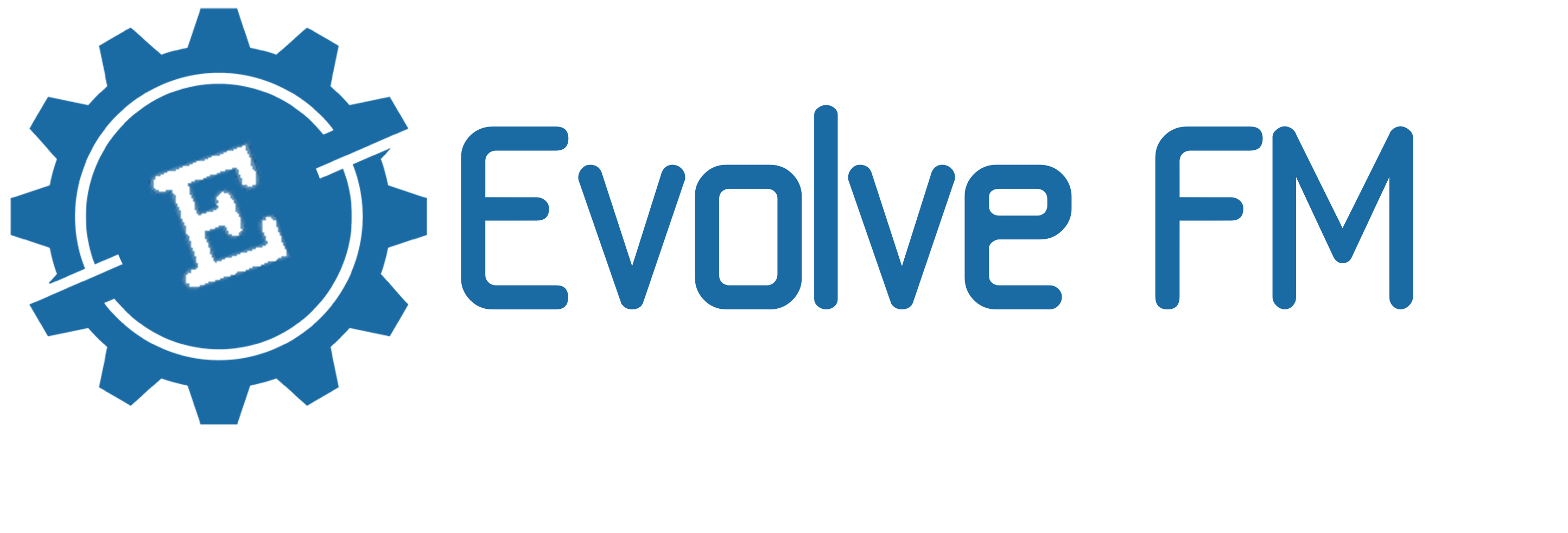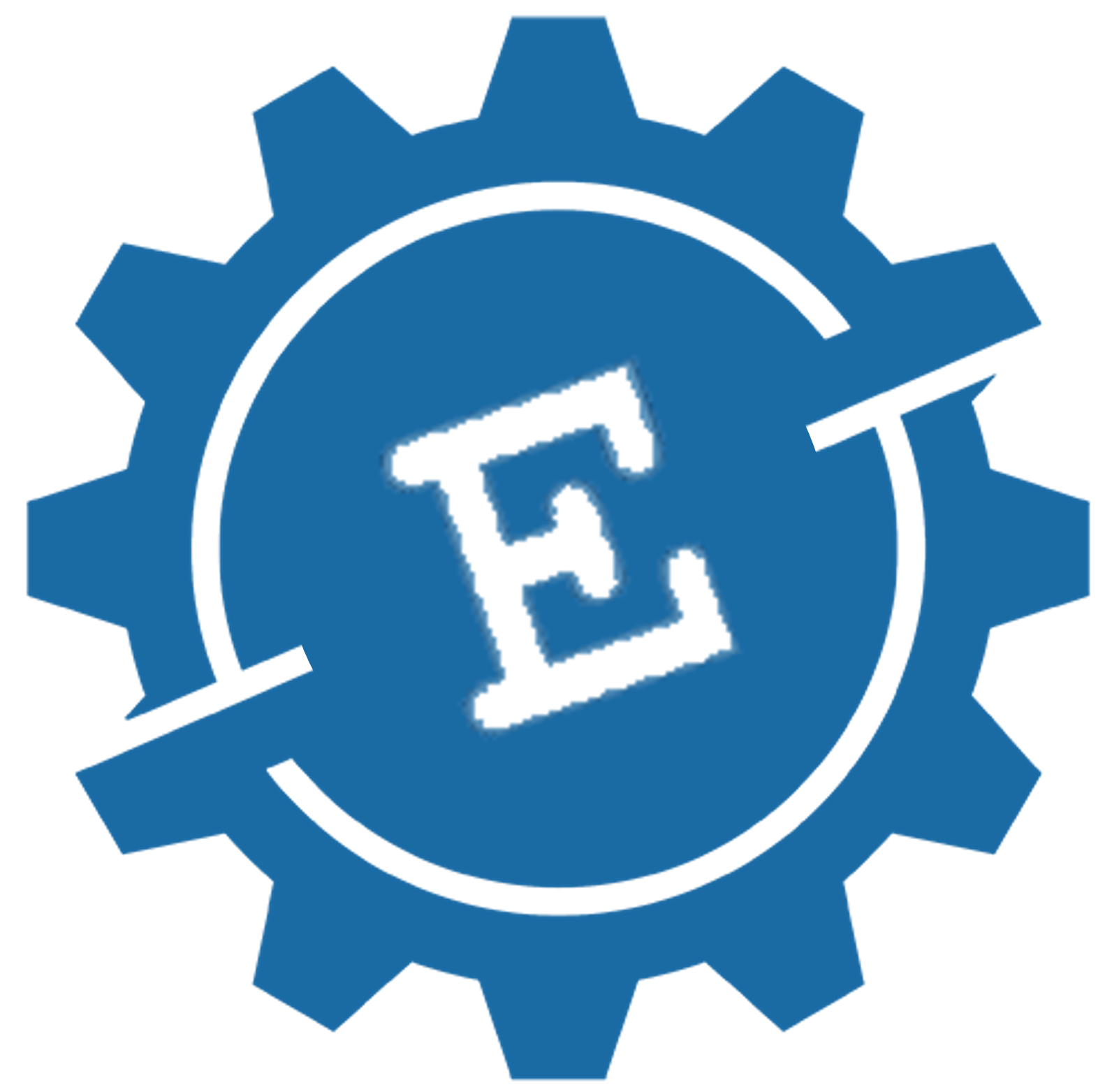CMMS Justification
Most managers find it increasingly difficult to control rising maintenance costs because of inadequate or outdated procedures. One tool that can help is a computerized maintenance management system (CMMS). The low cost of PCs and reasonable software cost put them within reach of many small maintenance shops. However, before considering the purchase of such a system, the company has to justify CMMS, which basically means convincing people. How do you convince different levels of management?
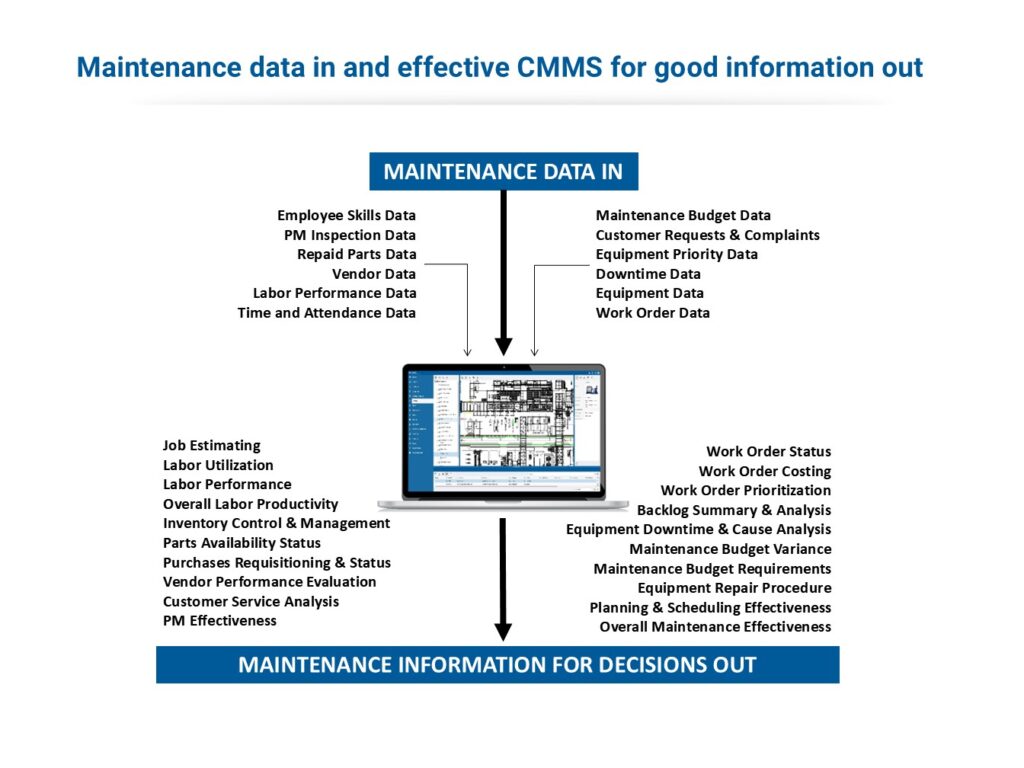
First, maintenance managers must determine whether a CMMS is beneficial to their operations. They must ask questions such as:
- How long can the plant tolerate a production line breakdown due to part unavailability (if maintenance stores are not properly monitored, the company may face more costly breakdowns)?
- How much more are we spending on maintenance today than five years ago?
- Do we have the information we need to plan maintenance operations?
- Can we get this information when we need it?
- Is it in usable form?
- What are the company’s plans for operations, for equipment?
- Will a computer really help?
The following questions also arise nearly every time maintenance is required on a piece of equipment:
- Where did we buy that last spare part?
- How much did we pay?
- Is this equipment under warranty?
- Who was the contact person we talked to?
- What was the phone number?
- Do we have a blanket purchase order with this vendor?
- How did we get the last part shipped?
- What was the delivery time?
Answers to these questions or inability to answer these will indicate a definite need for a CMMS. CMMS is useful even when the maintenance information system is basically sound but is not easily accessible or more information is needed.
Think about your maintenance system and how it affects other areas of operation such as production, accounting, payroll, and customer service. Could these operations be made more productive by improving the speed and efficiency of a maintenance information system? If the answer is yes, you could benefit from computerizing your maintenance system.
Another important issue to consider is the amount of information that can leave the company when a key maintenance employee leaves. Years of critical information can be lost the moment the employee walks out the door.
Roadblocks to CMMS Acquisition that need to be justified
Opposing the CMMS acquisition are the internal roadblocks that stand in the way of the system purchase. The following list will help you prepare for common roadblocks associated with acquiring a CMMS:
- Budget is not available now. This is one of the most common excuses offered by management. It shows lack of acceptance and/or commitment by management.
- Inadequate project payback or savings. One must do a thorough job of determining benefits and savings. You will find CMMS very easy to justify in most cases.
- Management information system (MIS) does not give high enough priority. MIS does not give enough importance to a CMMS project, thus creating a roadblock. If MIS supports the project, its chances of success are increased greatly. CMMS is complicated for many decision-makers. Helping MIS understand the importance of CMMS should be a primary goal of every potential user. With MIS on your side, it is easier to convince others.
- Failure to reach consensus. All parties involved disagree on either the need for a CMMS or on the features required in a CMMS.
- The company is too small for a system. This attitude suggests a basic lack of understanding of the true benefits and functions of a CMMS. It can pay for itself even for very small companies. There are many companies with just one maintenance technician successfully using a CMMS. A CMMS will help record and maintain the equipment histories that will be the basis for future repair/replacement decisions. An accurate and complete history can also describe how the job was done the last time, thus saving time associated with job redesign.
- The prior attempt failed. You should try again.
- Do not have enough computer capability. This is a common excuse. Computer hardware and software costs are all part of the justification process. Once the project is justified, purchase of computer hardware is not a problem.
- Do not believe a CMMS will work in our situation. As long as equipment requires maintenance, a CMMS will work.
- Have never considered the benefits. You should consider them now and go through the process of justification.
Step-by-Step in CMMS Justification Process
Following is an outline of procedures that can help you justify CMMS a computerized maintenance program for your application.
Form a team
The maintenance manager should assign one person (project leader) the responsibility of researching and justifying the CMMS.
Establish a team
The project leader should establish a team to assist him or her in the investigation. The team should consist of the plant engineer, maintenance manager, maintenance employees, and representatives from the data processing, purchasing, and accounting departments. Marketing, sales, and human resources should also be included. You should involve everyone who has any impact on this project. At a Later date, the coordinator may also need advice from the company’s legal department when agreements are needed between the software and hardware vendors.
Involving your employees in the automation process enables you to break down their resistance to computers and build enthusiasm for CMMS as a tool to facilitate their work.
Identity problems with the present system in the CMMS justification process
Problem analysis
First, determine exactly what problems pertain to the maintenance department. This is crucial to selecting and purchasing the proper CMMS package for your company’s specific needs. Ultimately, we will determine the optimal system to solve (or minimize) these problems. For example, two very common problems that exist in companies today are
- Excessive downtime
- Lack of inventory control
Excessive downtime is a problem that occurs all too often for a vari. ety of reasons. The causes range from lack of preventive maintenance (PM) to unavailability of parts when machines are down. The question that should be asked at this point is “can CMMS help with this?” The answer is ‘Yes.” The properly selected CMMS package can help with PM scheduling and better inventory control. CMMS justify
Some problems simply may not be solved with a CMMS, such as employee theft.
Discuss and brainstorm with others in the maintenance department and other departments as well. Talk to anyone that you believe will benefit or be impacted from CMMS. Create a list of your own with as many descriptive problems as possible within and related to mainte-nance. Take time to consider the causes, not just the effects. Focus on all your maintenance problems.
Now compare your list with the following list and check to make sure relevant problems are covered. Feel free to add those to your list. CMMS justify
Reorganize your list until you have a final list by categories. Note: Some problems may belong to multiple categories.
List of problems (Example) CMMS justify
Labor productivity
- Shortage of manpower
- Shortage of crafts to finish job
- Trouble justifying more manpower
- Union problems
- Employee no means to monitor and control
- Planning material is not available when needed or too much is in stock
- Planning the proper tools are not available or accessible for the job
- Planning the necessary craftspeople are not available to do the job
- Scheduling problems (manpower, material, equipment, and so forth)
- Crisis management
- Rescheduled job priorities
- Job priorities- which to do first?
- Utilization of manpower resources
- Looking for supervisor to get the job assignment
- Visiting job sites to determine what needs to be done
- Rounding up materials and making multiple trips to the warehouse
- Looking for tools
- Waiting for other crafts to finish
- Waiting for shutdown, clearance, and access to the job site
- Time wasted due to lack of information or drawings
- Time wasted due to canceled work orders
- Waiting for special tools or engineering specifications
- Paperwork-wasted time
- Extended coffee or lunch breaks
- Late start-up, early wash-up
- Attitude and motivation
- Lack of preventive maintenance
- Paperwork-lack of storage space or simply unorganized Equipment availability
- Spare parts are out of stock
- Justify upgrading existing equipment
- Machine no means to monitor and control/too much downtime
- Planning material is not available when needed to fix a machine problem
- Crisis management
- Lack of PM Inventory control
- Planning material is not available when needed to fix a machine problem
- The proper tools are not available or accessible for the job
- Spare parts are out of stock
- Too many parts
- Too many obsolete parts
- No information available for substitute parts Product quality
- Lack of history records
- Lack of training
- The necessary craftspeople are not available to do the job
- The proper tools are not available or accessible for the job
Environment controls
- Government/OSHA regulations
- Safety procedures and standards Management support
- Management philosophy conflicts
- Lack of communication with other departments/within the department
- Lack of support from other departments
- Lack of management support
- Lack of long-term planning Maintenance information
- Assets-recordkeeping
- Assets-identifying
- Lack of history records
- Cost control-budgeting/no control over budget
Determine objectives, features, and benefits
List short-range and long-range objectives. A typical short-range objective is to have inventory control computerized within 6 to 12 months. At that time you would have the facility for printing a current inventory status, reordering reports, and the like. Short-term objectives must complement the long-range objectives. Make a list of your long-range objectives over the next three to five years. Typical long-range objectives are to increase overall maintenance productivity and increase control through more timely information. CMMS justify
One cannot define good objectives without performing some preliminary work to determine these objectives. An excellent place to start is the list of your problems. For each problem definition there will be one or more objectives. For example:
Problem: Job planning time is high resulting in high job backlog; high emergency repairs. CMMS justify
Objective: Job planning time should decrease, backlog should decrease, and emergency repairs should decrease.
Put together a comprehensive list of your objectives. Some objectives (examples) are listed as follows:
Labor productivity
- There should be sufficient manpower to carry out maintenance tasks.
- There should be some way to measure and monitor employee productivity.
- Material and tools should be minimize when jobs are scheduled.
- Emergency repairs should be minimized.
- Rescheduling of jobs should be minimized.
- Work order instructions should be clear.
- Equipment should be available when jobs are scheduled.
Equipment availability
- Parts should be available when a job is scheduled for a piece of equipment.
- Equipment replacement analysis should be performed to aid equipment replacement decisions.
- Emergency repairs should be minimized.
- Proper PM should be performed.
Inventory control
- Parts should be available when needed and if appropriate.
- Excess inventory should be minimized.
- Obsolete parts should be eliminated.
- Substitute parts information should be available.
Features CMMS justify
The next step is to compile a list of desired and needed features in your CMMS package. Based on your problem definition, you compiled a list of objectives. Now, based on each objective, prepare a list of features. For example:
Problem. Job planning time is high, resulting in high job backlog and high emergency repairs. CMMS justify
Objective. Job planning time should decrease, backlog and emergency repairs should decrease.
Features. Should have a work order scheduling module to help reduce job planning time and backlog. Should have a PM scheduling module to help reduce emergency repairs.
Now, put together a comprehensive list of features needed in your CMMS package.
The maintenance management system should be totally integrated and designed for use by all levels of personnel at the plant. The integrated system means information entered at one point will automatically and instantly become available at all other appropriate places throughout the system. The key sections of the program should include (examples):
- Equipment identification
- Referencing and cross-referencing
- Complete and comprehensive equipment specifications
- Spare parts lists for each piece of equipment
- Stockroom inventory levels and purchasing records
- PM worksheets and check lists
- PM schedules
- Work order preparation instructions
- Outstanding work order listings and priorities
- Maintenance histories and downtime records
- Manpower summaries
- Equipment listings
- Work order inquiry
- Equipment cost histories
- Major overhaul standards
- Uniform methods to initiate work
- Procedure to approve and authorize work
- Weekly review of work priorities
- Weekly work program based on craft net capacity to do work
- Uniform methods to measure and control work backlog
- Recording man hours, materials, and job costs
- Uniform procedure to report completed work
The system should provide maintenance personnel with a clear picture of what is expected of them and adequate feedback on their performance. The system should also interface with existing plant information system where possible and necessary. CMMS justify
Benefits CMMS justify
In deciding to obtain a CMMS, the motivation is usually a combination of improved production and a savings in maintenance time and costs. Savings and improvements take many forms. They may be large or small, but they will be realized if a CMMS is successful. CMMS justify
Your task is to put together a list of benefits that would be obtained for your organization if a CMMS were implemented. Start with your list of problems. For each problem, you defined one or more objectives. You documented features corresponding to those objectives. Now, prepare a list of benefits corresponding to the features. For example:
Problem. Job planning time is high, resulting in high job backlog and high emergency repairs.
Objective. Job planning time should decrease, backlog should decrease, and emergency repairs should decrease.
Features. Should have a work order scheduling module to help reduce job planning time and backlog. Should have a PM scheduling module to help reduce emergency repairs.
Benefits. Increase in labor productivity (less money spent on overtime), Better equipment availability resulting in higher capacity output. This list of benefits is very important, as it will get translated into savings and help justify the system. At this point, you will end up with a spreadsheet like the one shown below:
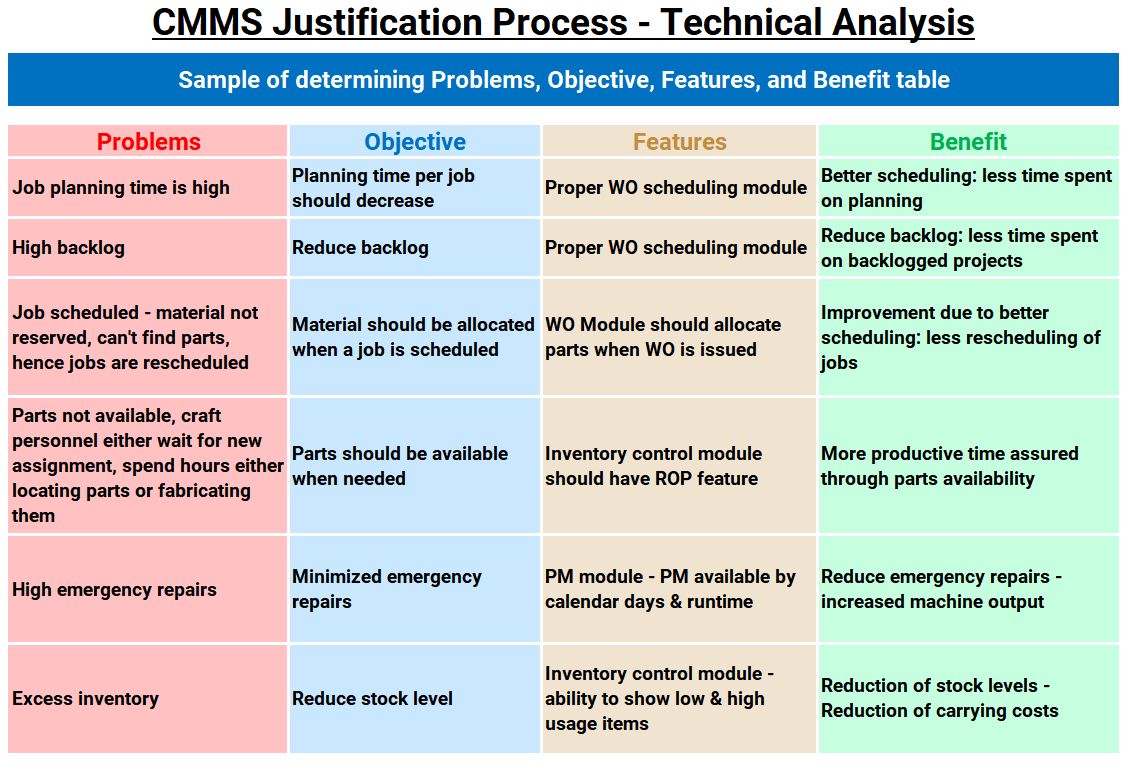
CMMS Justification Process – Technical Analysis
Examples of benefits CMMS justify
Increased labor productivity. If the system provides the employees with a planned job, the procedures, needed parts and tools; the employees will be able to go directly to the job and do the needed work with no delays or interruptions. The employee will also work more safely since job plans would include all safety procedures.
All this will increase labor productivity. Efficient asset management and maintenance scheduling will contribute to reduced overtime. Improved parts tracking and availability will reduce the unproductive time of employees. Overall you will witness:
- Reduction of overtime.
- Reduction of outside contract work.
- Reduced maintenance backlog.
- Reduced cost per repair.
- Improved morale of employees by diffusing employee frustration; a happy worker is a productive worker.
- Better service to other departments.
- A significant reduction in paperwork to make the most productive use of employee time.
- Effective utilization of maintenance and supervisory personnel’s time.
- Reduced follow-up role required of the supervisor.
Increased equipment availability. Within a few months of implementation, it will become much easier to identify repetitive faults and trends. This information will assist in maximizing equipment uptime and reducing breakdowns. Your emphasis should shift from reactive to proactive maintenance, and your ratio of percent planned to unplanned jobs should increase. A corresponding reduction in downtime will follow.
Savings through reduced production loss results primarily from performing adequate predictive maintenance (PdM) and PM.
PdM employs sensors or detectors to monitor equipment performance and condition. Detection of potential problems prompts the writing of the needed work order. For example, when an unacceptable reading of bearing temperature or vibration is sensed, a maintenance response can automatically initiate. The response may take the form of an automatic injection of lubricant or an initiation of a maintenance work order. CMMS justify
PdM helps keep the equipment in good condition. It leads to timely repairs rather than waiting for an actual failure to initiate corrective maintenance action.
PM is the regular scheduling of specific maintenance tasks to prevent possible anticipated failures. PM tasks include work such as a filter or bearing replacement, and calibration and condition checking.
An effective PM program will keep equipment in good condition because it forces periodic monitoring, and it serves as an early detection system for finding problems before they mature into full failures. The immediate result is that maintenance jobs are kept to a minimum size. The long-term result is that equipment retains its effectiveness, value, and reliability in supporting production.
Longer useful life of equipment. You can prolong the effective lifetime of your assets and equipment through regular; adequate PM. The CMMS will support the processes involved in prolonging the life of your assets, which also improves the resale value of the equipment. Overall you will witness a reduction in downtime.
Inventory control. Reduced Inventory Costs. Planning of jobs permits parts to be available when and where needed. Experience shows that a reduction of 10 to 15 percent in parts stocked and consumed is possible. Reductions also extend to inventory carrying charges, as well as to stockroom size, staff, and service requirements. CMMS justify
As work becomes more predictive so does your stock holding. Carrying out regular stock reviews allows you to minimize stock and to reduce expensive inventory. Spare parts can be linked to equipment, ensuring that obsolete parts are readily identified. Many users find that the greatest returns from a CMMS come through improvements in inventory control, with savings of 10 to 15 percent being typical.
Product quality. Improved product quality results primarily from performing adequate PM and PM. PdM and PM details are described in the section “Equipment availability” earlier. Good equipment condition assures good product quality.
Environment control
Safety issues. Preventing accidents and injuries as a result of proper procedures documented by CMMS can save you a significant amount of money.
Compliance issues. Compliance with industry regulations. Some industries such as food processing, pharmaceuticals, and petrochemicals require that your asset management systems comply with the national or international standards that regulate their industry. If you require such compliance then you should select a CMMS that has a provision for the same. Meeting the regulatory requirements can save you money that you would otherwise pay in fines for not meeting the requirements. CMMS justify
Maintenance information. Access to maintenance information is dramatically expanded. Other benefits are also expected of a CMMS. Improved reporting and support for management control can contribute strongly to justifying a CMMS. Crucial production line decisions can be simplified by dependable and timely data on equipment condition, and expected lifetime. Such information can provide guidance in setting the size of production runs, deciding on equipment replacement, and pricing the product.
Better management of service contracts. Service contracts are arrangements with outside contractors for continuing services such as fork truck maintenance. Because these services are managed maintenance, it is convenient to use the CMMS to manage the functionality and accounting part of the services.
Blanket Purchase Orders. Blanket purchase orders with parts and materials suppliers may be managed effectively by a CMMS. This is an important area for tight control as blanket purchase orders are proven to be major leakages in the maintenance budget.
Increase in overall plant productivity. In the process of evaluating the benefits, you should remember not to look at CMMS as a tool to reduce employment. Instead, they should be viewed as a tool to reduce the rate of future hiring. For example, acquiring a CMMS may permit you to continue to operate with one maintenance clerk as your business expands, instead of hiring another one. The CMMS will, however, allow one maintenance clerk to get more work done and to do the job faster and more accurately. CMMS justify
Financial analysis
Savings
The nature of saving through improved maintenance management can vary from one industry to another. Not all forms of saving and cost avoidance are available in very in every industry, nor are all savings sufficient to justify the installation of CMMS. Nevertheless, where justified, a system may pay for itself many times over through cost saving and avoidance.
So far, you have determined the benefits derived from using a CMMS. Now, calculate the savings offered in dollars by each benefit. You must do a detailed analysis of each benefit for your maintenance operation. For example:
- Problem: Job planning time is high, resulting in high job backlog and high emergency repairs.
- Objective: Job planning time should decrease, backlog should decrease, and emergency repairs should decrease.
- Futures: Should have a work order scheduling module to help reduce job planning time and backlog. should have a PM scheduling module to help reduce emergency repairs.
- Benefits: Increase in labor productivity (less money spent on overtime), better equipment availability resulting in higher capacity output.
Labour productivity
First year saving = $45,000
Second-year savings = $60,000
3rd year savings = $60,000
Higher capacity output
First year saving = $120,000
2nd year saving = $130,000
3rd year savings = $130,000
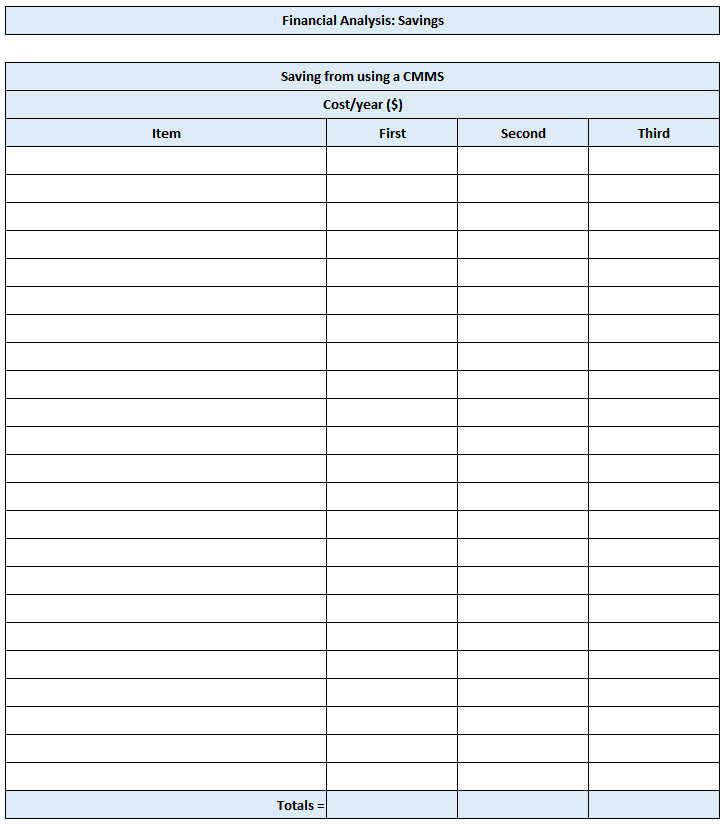
Table 3.2 Saving Forms Using a CMMS (Blank Form)
You can fill out Table 3.2 to document your savings. Put together as many benefit items as you have.
Table 3.3 shows typical savings generated in a maintenance department by use of a CMMS. If you don’t have the resources to compute detailed savings, you may use this data to determine savings for your organization.
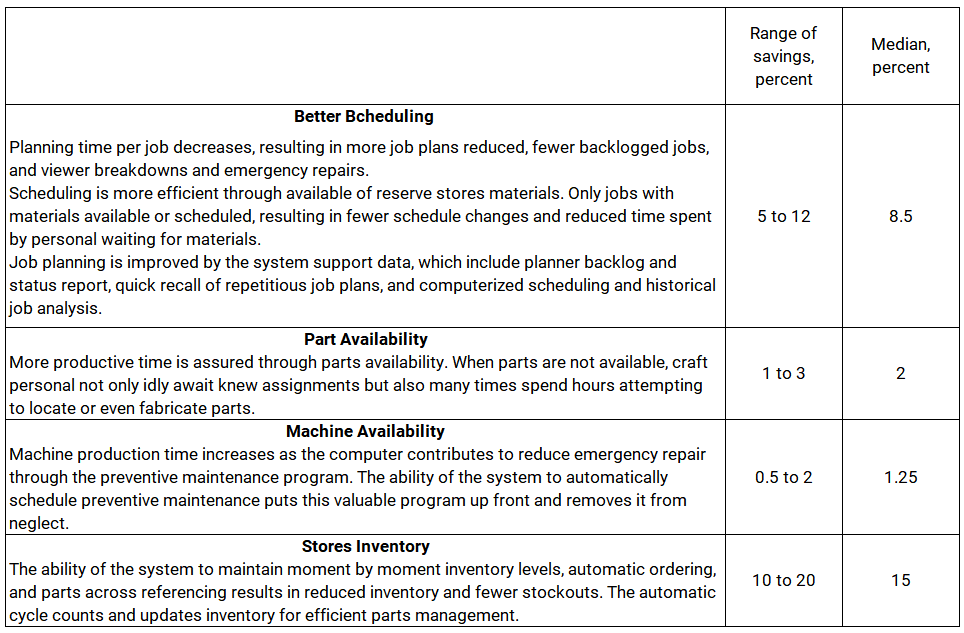
Cost estimates
Cost estimates
Obtine rough cost estimates:
- Research websites, catalogs, publications, and technical literature
- Call on software suppliers
- Calculate total software costs:
- system analysis and definitionprogram installation and testingthey taught entry(plant personal or outside help)software escalation costsinstallation costcost of modification, if anytraining costoperating cost
- software maintenance cost
- Calculate total hardware costs:
- hardwaremaintenance
- supplies
- Calculate total cost
Include every possible cost factor.
Determine net saving. Subtract the total fixed cost from the total savings to find the net savings.
Compute return on investment (ROI). A ROI calculation for justifying CMMS project results in a value that represents the savings (benefits) received from a CMMS against the total cost of implementing it.
The ROI can be calculated as follows:
ROI% = (total savings – total costs) / (total costs) x 100
Let’s say you are trying to compute the ROI for 2 years; then,
Total savings = (savings year 1 + savings year 2) / 2
Total costs = (costs year 1 + costs year 2) / 2
Set up key performance indicators (KPIs)
Once the CMMS is implemented, you have to make sure the savings documented in the justification are being realized. You also have to set KPIs in order to monitor and control the progress. You can define your own KPI’s. For example, let us say you are operating at 40% labor efficiency and your goal is to increase that to 75%. Then, your KPI is used to obtain a labor efficiency of 75%. You have to monitor progress and make sure your goal is achieved. You can revise your KPI’s on an annual basis or more frequently, if necessary.
Here are some examples of KPIs: (goals indicated or typical industry example. You can set your own goals.)
- Maintenance cost per unit of production. Obtained from completed work order CMMS reports and company financial reports. Benchmark actual costs against goals.
- Percentage of planned work orders completed as scheduled. To measure planning effectiveness. Obtained from CMMS for completed work order, compare date required to date completed (gold: 95%).
- The percentage of craft hours changes to work orders. To monitor resource accountability: obtained from CMMS: report of actual craft hours charged to work orders (goal: 100%)
- Percentage of planned Versus emergency work orders. To evaluate PM and planning effectiveness (goal: 90/10)
- percentage of craft utilization. Actual versus estimated time. To monitor and maximize craft resources (goal: 95%)
- overall equipment effectiveness oee. OEE is based on equipment availability, performance, and quality. This KPI is a measurement of the overall reliability improvement efforts (goal: 85%)
- Percentage of equipment availability. To monitor and minimize downtime (goal: 90%)
Conclusion CMMS justify
Follow the step-by-step process to justify a CMMS for your application. Identify your needs by reviewing your present practices. Determine the objectives, features, and benefits of a CMMS. Compute total project cost, savings, and ROI. Once the system is justified, put together KPIs and monitor them on a regular basis.
To discover more about the options that may be suitable for you, consider starting a free trial or reaching out to arrange a demo!
